Report: Effective Communication Skills for Children Client Group
VerifiedAdded on 2020/11/12
|7
|1432
|148
Report
AI Summary
This report examines effective communication skills when working with children, focusing on the unique challenges and strategies involved in this client group. It identifies key barriers such as children's cognitive development, attention spans, and trust issues, highlighting the need for tailored communication approaches. The report emphasizes essential communication skills, including active listening, non-verbal communication, clarity, and friendliness. Furthermore, it explores resources like video presentations, non-verbal cues, and peer influence to enhance communication effectiveness. The report concludes that employing these skills and resources is crucial for professionals to meet the needs of children clients and achieve successful outcomes. The report also includes several references to academic journals and books.
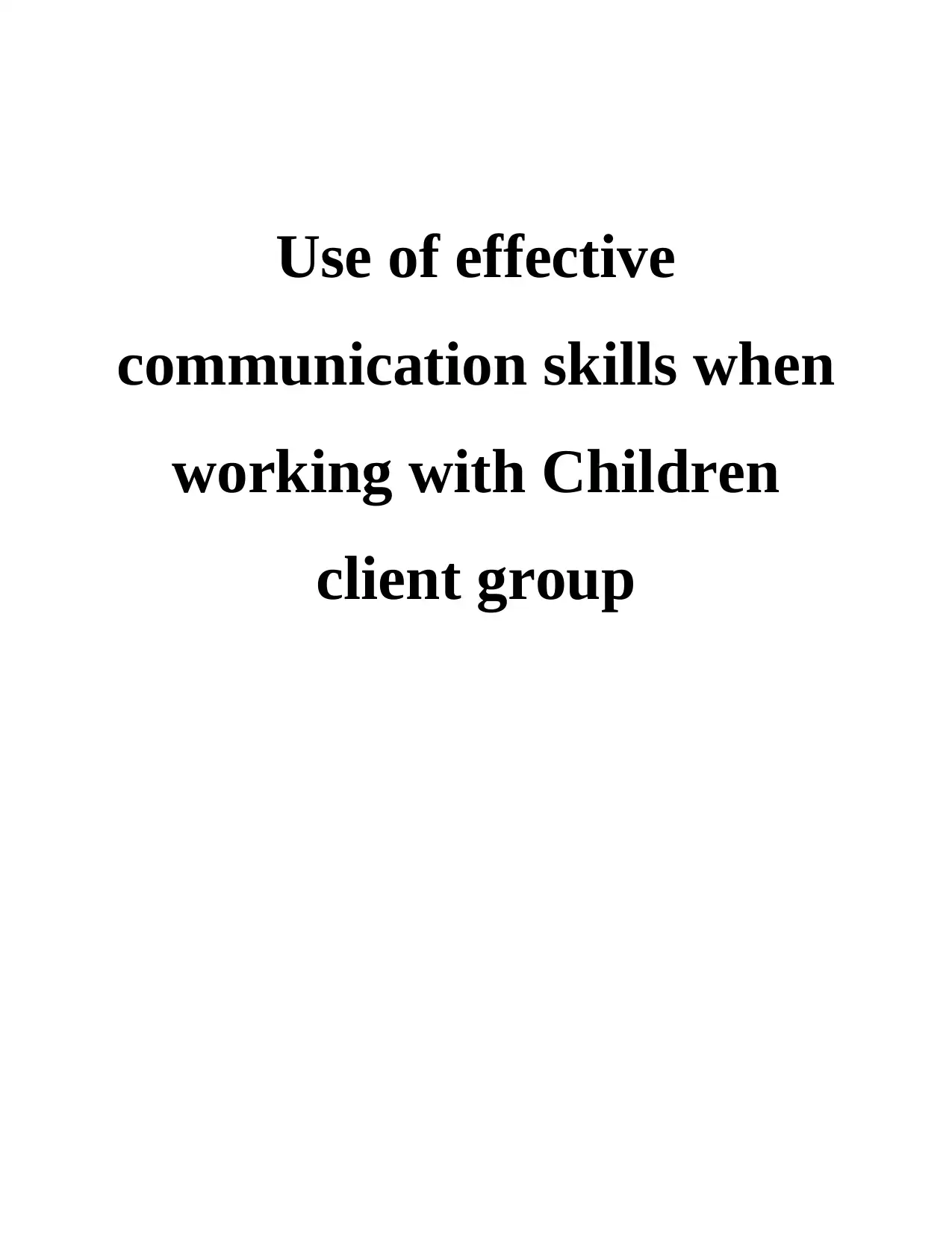
Use of effective
communication skills when
working with Children
client group
communication skills when
working with Children
client group
Paraphrase This Document
Need a fresh take? Get an instant paraphrase of this document with our AI Paraphraser
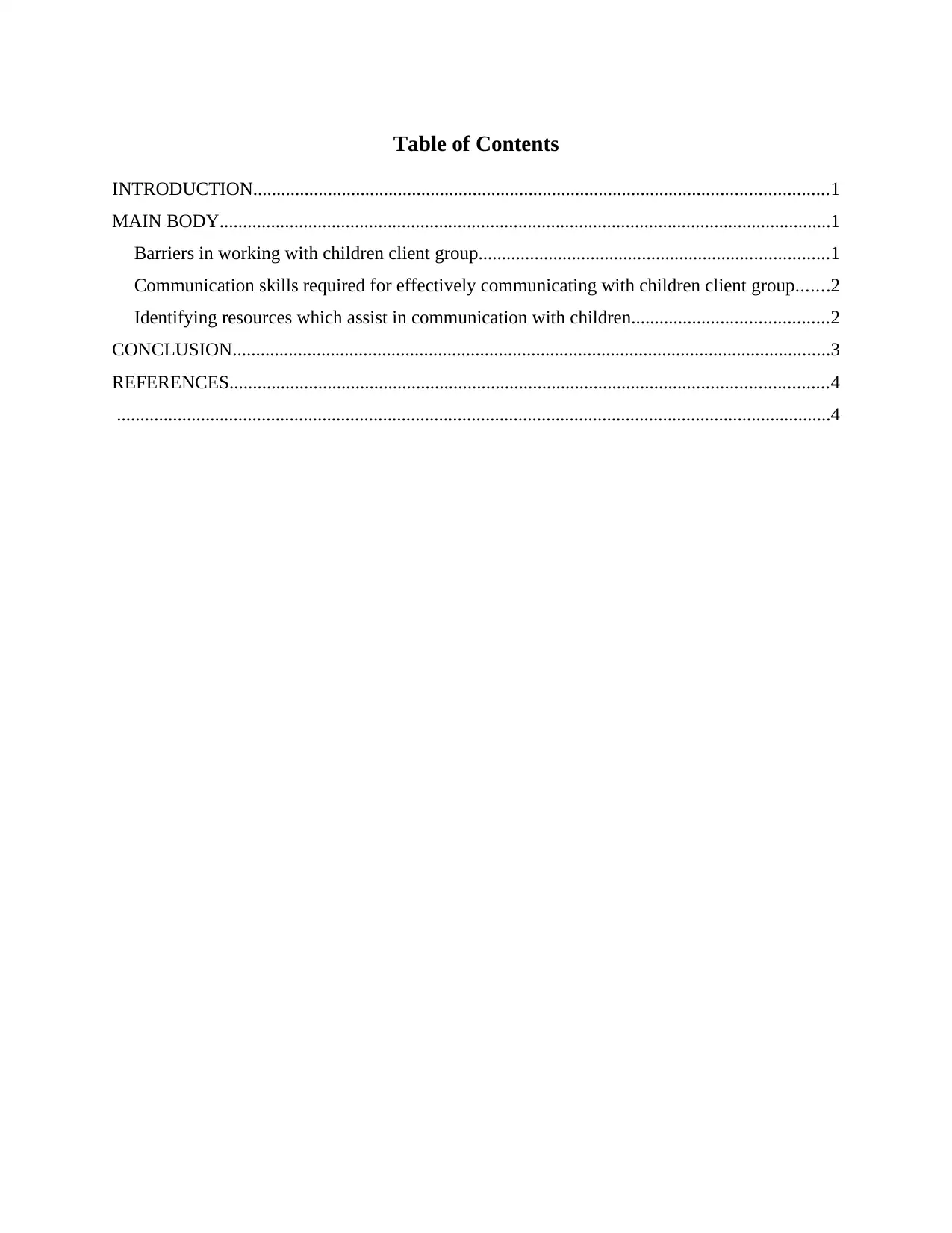
Table of Contents
INTRODUCTION...........................................................................................................................1
MAIN BODY...................................................................................................................................1
Barriers in working with children client group...........................................................................1
Communication skills required for effectively communicating with children client group.......2
Identifying resources which assist in communication with children..........................................2
CONCLUSION................................................................................................................................3
REFERENCES................................................................................................................................4
.........................................................................................................................................................4
INTRODUCTION...........................................................................................................................1
MAIN BODY...................................................................................................................................1
Barriers in working with children client group...........................................................................1
Communication skills required for effectively communicating with children client group.......2
Identifying resources which assist in communication with children..........................................2
CONCLUSION................................................................................................................................3
REFERENCES................................................................................................................................4
.........................................................................................................................................................4

⊘ This is a preview!⊘
Do you want full access?
Subscribe today to unlock all pages.

Trusted by 1+ million students worldwide
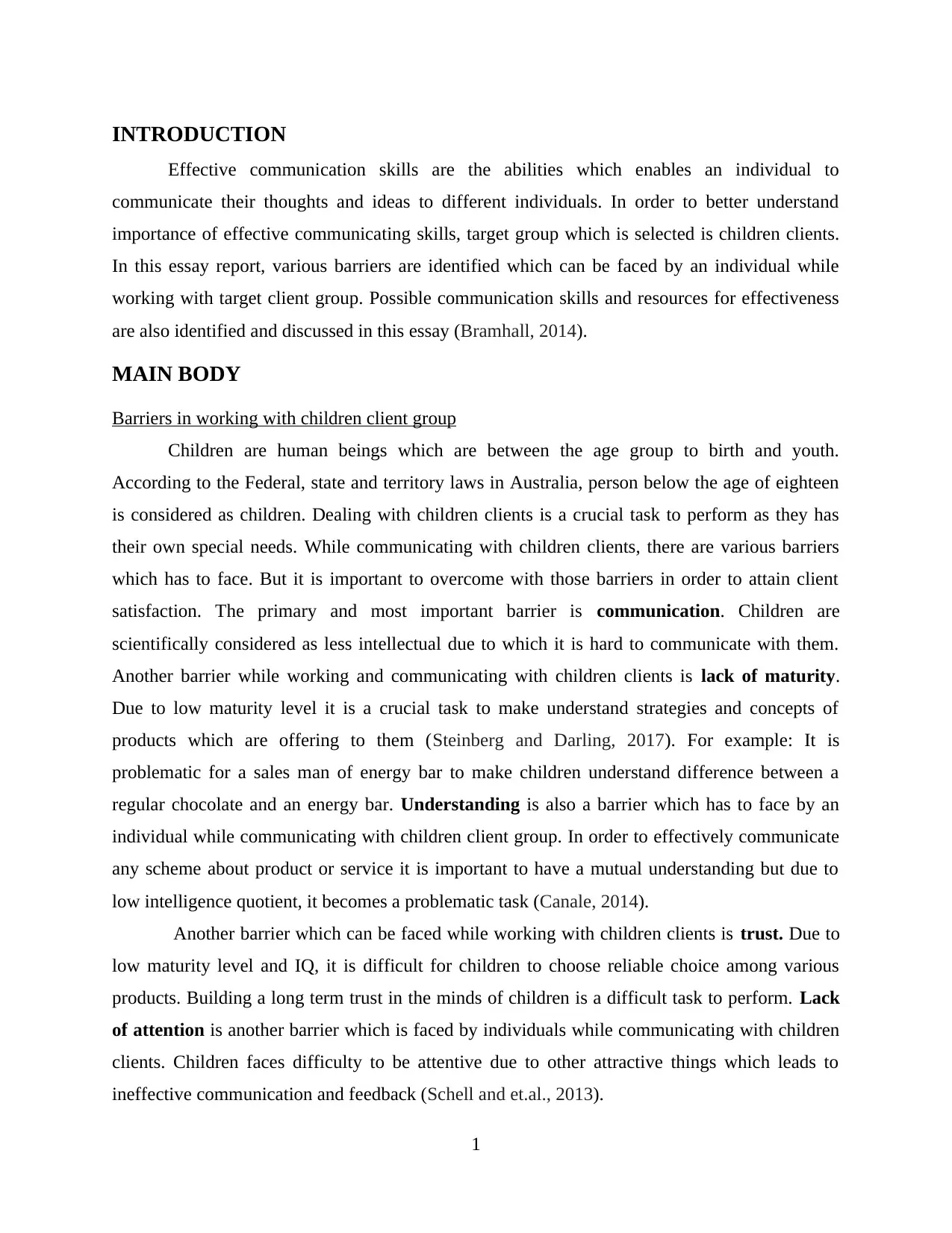
INTRODUCTION
Effective communication skills are the abilities which enables an individual to
communicate their thoughts and ideas to different individuals. In order to better understand
importance of effective communicating skills, target group which is selected is children clients.
In this essay report, various barriers are identified which can be faced by an individual while
working with target client group. Possible communication skills and resources for effectiveness
are also identified and discussed in this essay (Bramhall, 2014).
MAIN BODY
Barriers in working with children client group
Children are human beings which are between the age group to birth and youth.
According to the Federal, state and territory laws in Australia, person below the age of eighteen
is considered as children. Dealing with children clients is a crucial task to perform as they has
their own special needs. While communicating with children clients, there are various barriers
which has to face. But it is important to overcome with those barriers in order to attain client
satisfaction. The primary and most important barrier is communication. Children are
scientifically considered as less intellectual due to which it is hard to communicate with them.
Another barrier while working and communicating with children clients is lack of maturity.
Due to low maturity level it is a crucial task to make understand strategies and concepts of
products which are offering to them (Steinberg and Darling, 2017). For example: It is
problematic for a sales man of energy bar to make children understand difference between a
regular chocolate and an energy bar. Understanding is also a barrier which has to face by an
individual while communicating with children client group. In order to effectively communicate
any scheme about product or service it is important to have a mutual understanding but due to
low intelligence quotient, it becomes a problematic task (Canale, 2014).
Another barrier which can be faced while working with children clients is trust. Due to
low maturity level and IQ, it is difficult for children to choose reliable choice among various
products. Building a long term trust in the minds of children is a difficult task to perform. Lack
of attention is another barrier which is faced by individuals while communicating with children
clients. Children faces difficulty to be attentive due to other attractive things which leads to
ineffective communication and feedback (Schell and et.al., 2013).
1
Effective communication skills are the abilities which enables an individual to
communicate their thoughts and ideas to different individuals. In order to better understand
importance of effective communicating skills, target group which is selected is children clients.
In this essay report, various barriers are identified which can be faced by an individual while
working with target client group. Possible communication skills and resources for effectiveness
are also identified and discussed in this essay (Bramhall, 2014).
MAIN BODY
Barriers in working with children client group
Children are human beings which are between the age group to birth and youth.
According to the Federal, state and territory laws in Australia, person below the age of eighteen
is considered as children. Dealing with children clients is a crucial task to perform as they has
their own special needs. While communicating with children clients, there are various barriers
which has to face. But it is important to overcome with those barriers in order to attain client
satisfaction. The primary and most important barrier is communication. Children are
scientifically considered as less intellectual due to which it is hard to communicate with them.
Another barrier while working and communicating with children clients is lack of maturity.
Due to low maturity level it is a crucial task to make understand strategies and concepts of
products which are offering to them (Steinberg and Darling, 2017). For example: It is
problematic for a sales man of energy bar to make children understand difference between a
regular chocolate and an energy bar. Understanding is also a barrier which has to face by an
individual while communicating with children client group. In order to effectively communicate
any scheme about product or service it is important to have a mutual understanding but due to
low intelligence quotient, it becomes a problematic task (Canale, 2014).
Another barrier which can be faced while working with children clients is trust. Due to
low maturity level and IQ, it is difficult for children to choose reliable choice among various
products. Building a long term trust in the minds of children is a difficult task to perform. Lack
of attention is another barrier which is faced by individuals while communicating with children
clients. Children faces difficulty to be attentive due to other attractive things which leads to
ineffective communication and feedback (Schell and et.al., 2013).
1
Paraphrase This Document
Need a fresh take? Get an instant paraphrase of this document with our AI Paraphraser
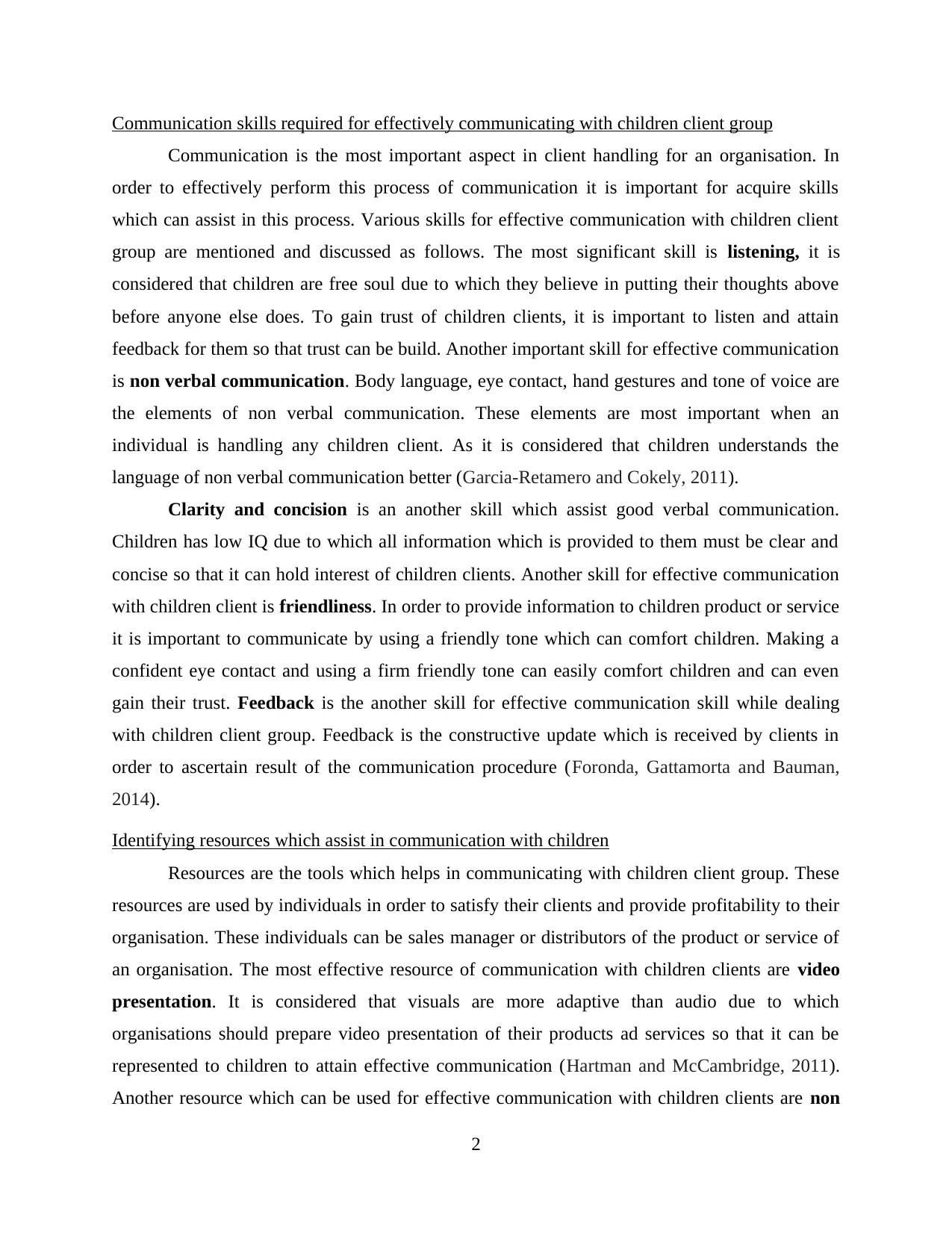
Communication skills required for effectively communicating with children client group
Communication is the most important aspect in client handling for an organisation. In
order to effectively perform this process of communication it is important for acquire skills
which can assist in this process. Various skills for effective communication with children client
group are mentioned and discussed as follows. The most significant skill is listening, it is
considered that children are free soul due to which they believe in putting their thoughts above
before anyone else does. To gain trust of children clients, it is important to listen and attain
feedback for them so that trust can be build. Another important skill for effective communication
is non verbal communication. Body language, eye contact, hand gestures and tone of voice are
the elements of non verbal communication. These elements are most important when an
individual is handling any children client. As it is considered that children understands the
language of non verbal communication better (Garcia-Retamero and Cokely, 2011).
Clarity and concision is an another skill which assist good verbal communication.
Children has low IQ due to which all information which is provided to them must be clear and
concise so that it can hold interest of children clients. Another skill for effective communication
with children client is friendliness. In order to provide information to children product or service
it is important to communicate by using a friendly tone which can comfort children. Making a
confident eye contact and using a firm friendly tone can easily comfort children and can even
gain their trust. Feedback is the another skill for effective communication skill while dealing
with children client group. Feedback is the constructive update which is received by clients in
order to ascertain result of the communication procedure (Foronda, Gattamorta and Bauman,
2014).
Identifying resources which assist in communication with children
Resources are the tools which helps in communicating with children client group. These
resources are used by individuals in order to satisfy their clients and provide profitability to their
organisation. These individuals can be sales manager or distributors of the product or service of
an organisation. The most effective resource of communication with children clients are video
presentation. It is considered that visuals are more adaptive than audio due to which
organisations should prepare video presentation of their products ad services so that it can be
represented to children to attain effective communication (Hartman and McCambridge, 2011).
Another resource which can be used for effective communication with children clients are non
2
Communication is the most important aspect in client handling for an organisation. In
order to effectively perform this process of communication it is important for acquire skills
which can assist in this process. Various skills for effective communication with children client
group are mentioned and discussed as follows. The most significant skill is listening, it is
considered that children are free soul due to which they believe in putting their thoughts above
before anyone else does. To gain trust of children clients, it is important to listen and attain
feedback for them so that trust can be build. Another important skill for effective communication
is non verbal communication. Body language, eye contact, hand gestures and tone of voice are
the elements of non verbal communication. These elements are most important when an
individual is handling any children client. As it is considered that children understands the
language of non verbal communication better (Garcia-Retamero and Cokely, 2011).
Clarity and concision is an another skill which assist good verbal communication.
Children has low IQ due to which all information which is provided to them must be clear and
concise so that it can hold interest of children clients. Another skill for effective communication
with children client is friendliness. In order to provide information to children product or service
it is important to communicate by using a friendly tone which can comfort children. Making a
confident eye contact and using a firm friendly tone can easily comfort children and can even
gain their trust. Feedback is the another skill for effective communication skill while dealing
with children client group. Feedback is the constructive update which is received by clients in
order to ascertain result of the communication procedure (Foronda, Gattamorta and Bauman,
2014).
Identifying resources which assist in communication with children
Resources are the tools which helps in communicating with children client group. These
resources are used by individuals in order to satisfy their clients and provide profitability to their
organisation. These individuals can be sales manager or distributors of the product or service of
an organisation. The most effective resource of communication with children clients are video
presentation. It is considered that visuals are more adaptive than audio due to which
organisations should prepare video presentation of their products ad services so that it can be
represented to children to attain effective communication (Hartman and McCambridge, 2011).
Another resource which can be used for effective communication with children clients are non
2
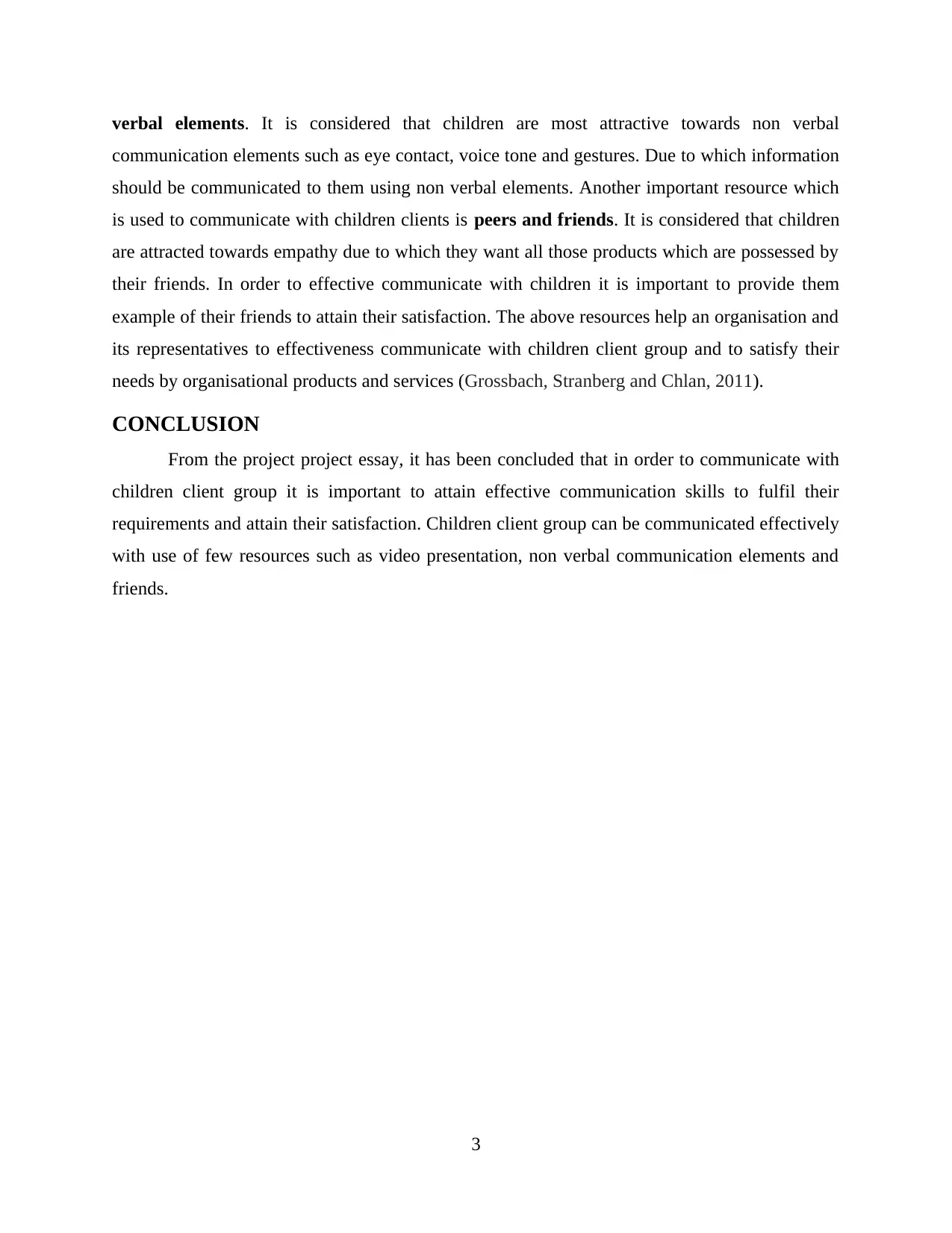
verbal elements. It is considered that children are most attractive towards non verbal
communication elements such as eye contact, voice tone and gestures. Due to which information
should be communicated to them using non verbal elements. Another important resource which
is used to communicate with children clients is peers and friends. It is considered that children
are attracted towards empathy due to which they want all those products which are possessed by
their friends. In order to effective communicate with children it is important to provide them
example of their friends to attain their satisfaction. The above resources help an organisation and
its representatives to effectiveness communicate with children client group and to satisfy their
needs by organisational products and services (Grossbach, Stranberg and Chlan, 2011).
CONCLUSION
From the project project essay, it has been concluded that in order to communicate with
children client group it is important to attain effective communication skills to fulfil their
requirements and attain their satisfaction. Children client group can be communicated effectively
with use of few resources such as video presentation, non verbal communication elements and
friends.
3
communication elements such as eye contact, voice tone and gestures. Due to which information
should be communicated to them using non verbal elements. Another important resource which
is used to communicate with children clients is peers and friends. It is considered that children
are attracted towards empathy due to which they want all those products which are possessed by
their friends. In order to effective communicate with children it is important to provide them
example of their friends to attain their satisfaction. The above resources help an organisation and
its representatives to effectiveness communicate with children client group and to satisfy their
needs by organisational products and services (Grossbach, Stranberg and Chlan, 2011).
CONCLUSION
From the project project essay, it has been concluded that in order to communicate with
children client group it is important to attain effective communication skills to fulfil their
requirements and attain their satisfaction. Children client group can be communicated effectively
with use of few resources such as video presentation, non verbal communication elements and
friends.
3
⊘ This is a preview!⊘
Do you want full access?
Subscribe today to unlock all pages.

Trusted by 1+ million students worldwide
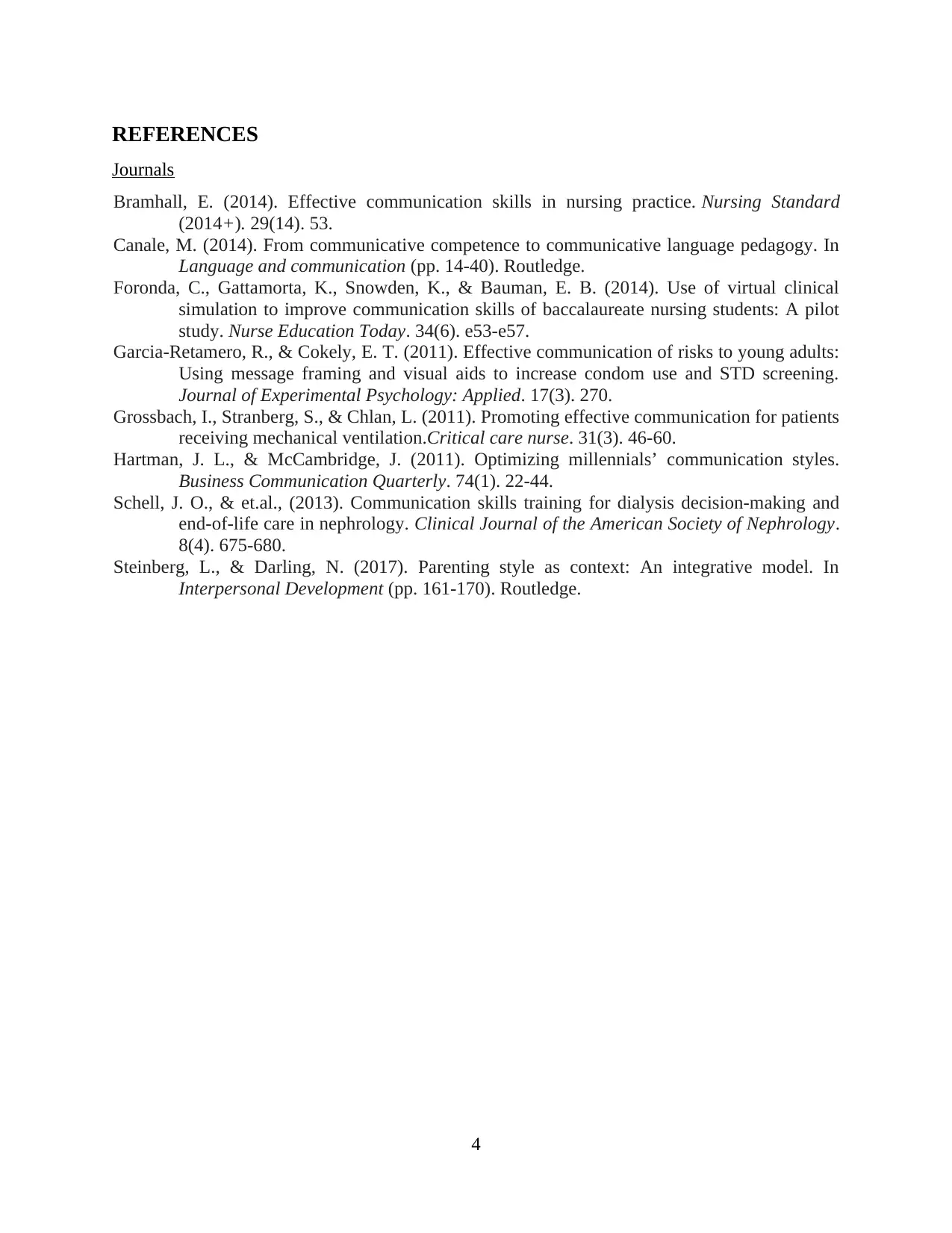
REFERENCES
Journals
Bramhall, E. (2014). Effective communication skills in nursing practice. Nursing Standard
(2014+). 29(14). 53.
Canale, M. (2014). From communicative competence to communicative language pedagogy. In
Language and communication (pp. 14-40). Routledge.
Foronda, C., Gattamorta, K., Snowden, K., & Bauman, E. B. (2014). Use of virtual clinical
simulation to improve communication skills of baccalaureate nursing students: A pilot
study. Nurse Education Today. 34(6). e53-e57.
Garcia-Retamero, R., & Cokely, E. T. (2011). Effective communication of risks to young adults:
Using message framing and visual aids to increase condom use and STD screening.
Journal of Experimental Psychology: Applied. 17(3). 270.
Grossbach, I., Stranberg, S., & Chlan, L. (2011). Promoting effective communication for patients
receiving mechanical ventilation.Critical care nurse. 31(3). 46-60.
Hartman, J. L., & McCambridge, J. (2011). Optimizing millennials’ communication styles.
Business Communication Quarterly. 74(1). 22-44.
Schell, J. O., & et.al., (2013). Communication skills training for dialysis decision-making and
end-of-life care in nephrology. Clinical Journal of the American Society of Nephrology.
8(4). 675-680.
Steinberg, L., & Darling, N. (2017). Parenting style as context: An integrative model. In
Interpersonal Development (pp. 161-170). Routledge.
4
Journals
Bramhall, E. (2014). Effective communication skills in nursing practice. Nursing Standard
(2014+). 29(14). 53.
Canale, M. (2014). From communicative competence to communicative language pedagogy. In
Language and communication (pp. 14-40). Routledge.
Foronda, C., Gattamorta, K., Snowden, K., & Bauman, E. B. (2014). Use of virtual clinical
simulation to improve communication skills of baccalaureate nursing students: A pilot
study. Nurse Education Today. 34(6). e53-e57.
Garcia-Retamero, R., & Cokely, E. T. (2011). Effective communication of risks to young adults:
Using message framing and visual aids to increase condom use and STD screening.
Journal of Experimental Psychology: Applied. 17(3). 270.
Grossbach, I., Stranberg, S., & Chlan, L. (2011). Promoting effective communication for patients
receiving mechanical ventilation.Critical care nurse. 31(3). 46-60.
Hartman, J. L., & McCambridge, J. (2011). Optimizing millennials’ communication styles.
Business Communication Quarterly. 74(1). 22-44.
Schell, J. O., & et.al., (2013). Communication skills training for dialysis decision-making and
end-of-life care in nephrology. Clinical Journal of the American Society of Nephrology.
8(4). 675-680.
Steinberg, L., & Darling, N. (2017). Parenting style as context: An integrative model. In
Interpersonal Development (pp. 161-170). Routledge.
4
1 out of 7
Related Documents
Your All-in-One AI-Powered Toolkit for Academic Success.
+13062052269
info@desklib.com
Available 24*7 on WhatsApp / Email
![[object Object]](/_next/static/media/star-bottom.7253800d.svg)
Unlock your academic potential
Copyright © 2020–2025 A2Z Services. All Rights Reserved. Developed and managed by ZUCOL.





